Intel's Core i7 870 & i5 750, Lynnfield: Harder, Better, Faster Stronger
by Anand Lal Shimpi on September 8, 2009 12:00 AM EST- Posted in
- CPUs
New Heatsinks and Motherboards
LGA-1156 processors use a different heatsink than both LGA-1366 and LGA-775 chips.
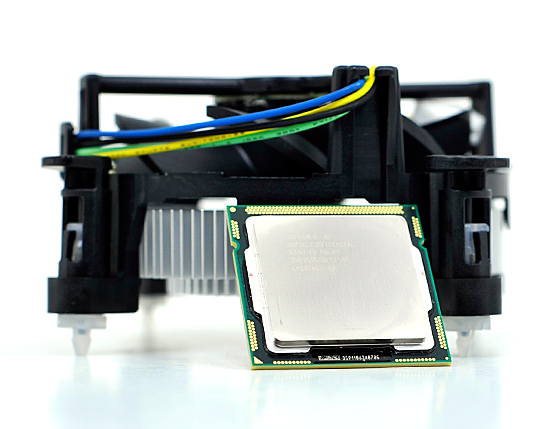
Lynnfield and its cooler
As the numbers would imply, the LGA-1156 heatsink has a larger footprint than LGA-775 but smaller than LGA-1366.
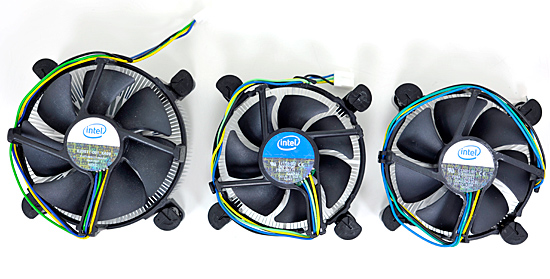
From Left to Right: Retail LGA-1366 Cooler, Retail LGA-1156 Cooler, Retail 45nm LGA-775 Cooler
The retail LGA-1156 is actually much closer to the 45nm LGA-775 retail cooler than the LGA-1366 retail HSF:
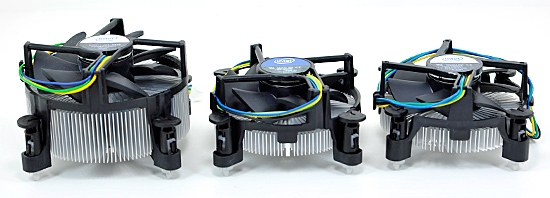
As you'll see later on in the article, the retail cooler isn't very good for heavy overclocking. Power users will want something a little bigger:
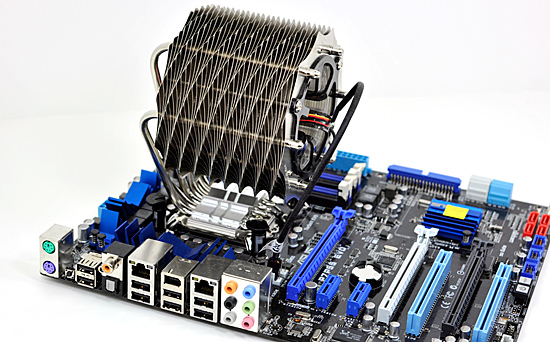
The Lynnfield/P55 launch is huge. Virtually every single motherboard manufacturer has a P55 board available. Prices range from ~$110 - $300 depending on the number of bells and whistles.

Gigabyte's ultra high end UD6 (left) and Gigabyte's lower end micro-ATX UD4 (right)
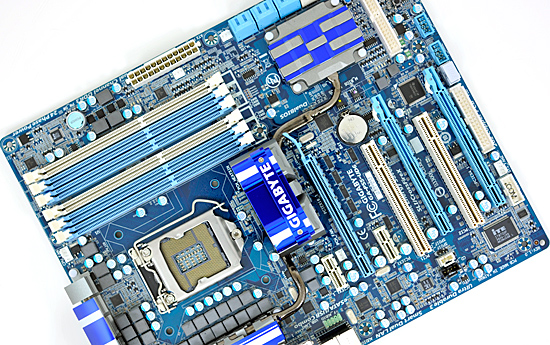
Gigabyte's high end UD6 comes with 6 DIMM slots like its X58 brethren.
Micro-ATX is increasing in popularity and we actually have some good options this time if you're trying to build a smaller Lynnfield system. Combined with Lynnfield's excellent idle power (the lowest of any quad-core we've ever tested), this could make for an unusually potent HTPC.
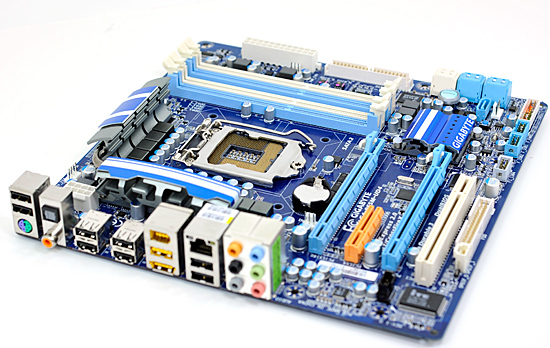
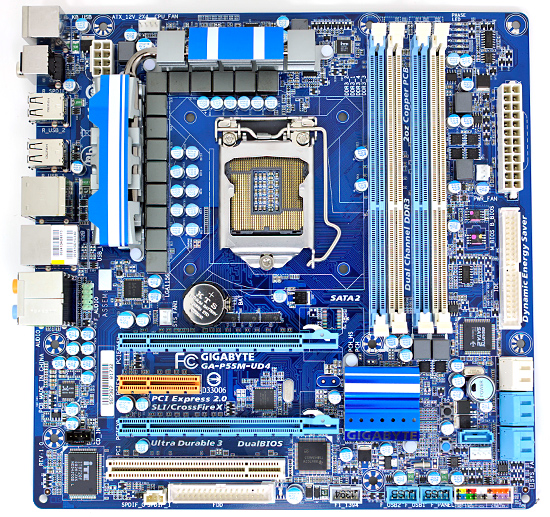
A closer look at Gigabyte's micro-ATX P55M-UD4
The only thing we're really missing is a good mini-ITX Lynnfield board. But perhaps the manufacturers will wait until we have on-package graphics before going down that route...
One More Time: New H55 Boards Next Year
As I subtley implied at the end of the last section, Intel is bringing on-package graphics to Nehalem starting in Q4 of this year:
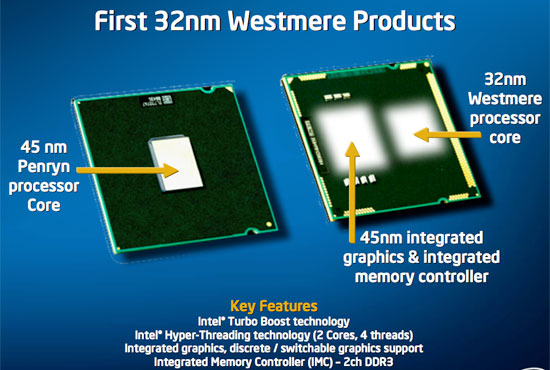
The 32nm Nehalem shrink, codenamed Westmere, will be available with a 45nm Intel graphics core on the processor's package. This graphics core is an evolution of what's currently in the G45 chipset and not Larrabee (although eventually that will change). From what I've heard, this is actually going to be Intel's first reasonably good integrated graphics core.
With the graphics on-package, there needs to be an interface from the processor socket to video output located on the motherboard. As you can see from the P55 motherboards that are launching today: none of them have this video out. Granted there aren't any CPUs out to take advantage of it either.

No DVI/HDMI/VGA out...yet
Early next year (or maybe even late this year) we'll see a new breed of LGA-1156 motherboards with video output, designed for use with these Westmere IGP parts. Rumor has it that these motherboards will use Intel's H55 chipset.
Lynnfield early adopters need not worry, 32nm quad-core processors won't be out for at least a year.










343 Comments
View All Comments
JonnyDough - Thursday, September 10, 2009 - link
Were you purposely reiterating my point? :DI don't think AMD ever much cared about what Intel was doing. In business class I was taught to keep an eye on a competitor but to really focus on what you are doing. I think AMD was planning their next move, and it had little to do with what Intel was doing or planned on doing, but rather the reaction of what Intel would do when they created Athlon and the next step to being a successful innovative company. Going graphics was just a logical step, since NVidia had no real competition in this space. They saw a market that was ruled by two giants, and decided to combine technology. I'm not so sure that Intel had the idea first. Don't forget, there are leaks in this industry, and people are getting paid to snitch.
tajmahal - Tuesday, September 8, 2009 - link
This is the first time i've ever seen an article written using wholesale x 1,000 prices. Is there any reason you didn't take the trouble to post actual retail pricing?JonnyDough - Tuesday, September 8, 2009 - link
He probably wrote this article prior to today and based it off Intel's pricing scheme...I would think you'd probably gather that. NewEgg is also not the only E-tailer/Retailer out there...ViRGE - Tuesday, September 8, 2009 - link
The last time I checked, those are the only prices Intel gives out. The actual retail prices are a combination of what the retailer paid (buy more, spend less) and whatever markup they add. Intel doesn't have an MSRP.tajmahal - Tuesday, September 8, 2009 - link
i5 750 = $210i7 860 = $300
i7 870 = $580
Just in case someone wants to buy just 1 instead of 1,000. Newegg prices
Gary Key - Tuesday, September 8, 2009 - link
"i5 750 = $210i7 860 = $300
i7 870 = $580
Just in case someone wants to buy just 1 instead of 1,000. Newegg prices "
Retail prices fluctuate greatly at launch. This is what I paid for our retail processors with tax mind you. ;)
i5 750 = $205
i7 860 = $306
i7 870 = $564
cycleback - Tuesday, September 8, 2009 - link
Could you post some Linpack and finite element code benchmarks. This would approximate a larger number of HPC workloads. I would really appreciate this as it is difficult to find these sorts of benchmarks. It would also really test the difference in memory bandwidth between Bloomfield and Lynfield.tacoburrito - Tuesday, September 8, 2009 - link
From the benchmarks, the i7 920 and the i5 seems to be even; each winning about half the benchmarks. If costs for both are the same (proc and mobo), I think I'd still go with the 920. Of course I can stop being a cheap bastard and spring for the i7 860.tacoburrito - Tuesday, September 8, 2009 - link
I also meant to add that it should just be a matter of time before Intel cut the prices of the 920.TA152H - Tuesday, September 8, 2009 - link
One thing that's obvious is, after reading this, that the esteemed reviewer modified his review in order to fulfill his preconceived ideas of what he wanted to say. It's really a terrible review.Most people know this site isn't technical, but still, I always thought it was unbiased. It's biased, big time, just not for a company. It's about making a review say what they want.
For example, I doubt Anand is really as stupid as he sounds in this article. LGA1366 has so many advantages, certainly he knows this. But why the idiotic remarks about asking why it exists?
Why did this review ignore the fact that most people here overclock? Why did it ignore that most people reading these reviews won't use DDR3 1066 memory? Did this site just try to become PC Magazine without the writing talent, and go stock? I think not. It was because they only wanted to give information that was consistent with their preconceived idea.
But, let's look closer. The memory controller on the Bloomfield is actually faster than the Lynnfield when using the same memory, even when running in dual channel mode. Why wasn't it mentioned here?
Why wasn't a clock normalized comparison between the LGA1366 processors and LGA1156 processors made, or even attempted, to get an idea of what the architecture changes accounted for? Strange that this very important data is missing? I think so.
Why weren't overclock processors compared? I mean, will anyone here buy an i7 920 and not overclock it? Probably not many. Since the only real advantage is the more aggressive turbo mode, this was what the article was based on. But, in reality, for readers here, it's not important, since people are going to overclock, and the i7 920 would wipe the floor up with the Lynnfields in the configuration that would be used. Why no mention of this?
There are better sites that have answered these questions. I used to like this site, but this review is another disappointment.
Let's be real though, it looks like the processor's horrible performance in the pre-release configuration is just a bad memory. It's not a bad part by any stretch, but it's hardly made the LGA1366 useless, or even the i7 920. The technical savvy will still opt for it in a lot of instances, since they will overclock it. If you have to recommend something for a friend that won't, these things are fine.
Another really stupid remark was how AMD processors would only make sense if they drop the price. Have you forgotten AMD processors are coupled with excellent IGPs? That's been the big selling point for a while, and this hasn't really changed that, too much. IGP platforms are really big in sales too, so, I'd agree with the premise that AMD probably should lower their prices a little, but not that they don't have advantages even where they are. The processors don't, but you can't get an Intel motherboard with the 790GX either. And if they come out with something better, as rumored, it's just going to give their platform another advantage to help counteract their horrible processors (yes, I agree they suck).